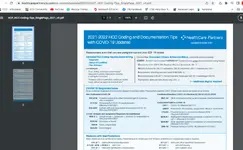Yearly Reporting Requirement
A major component of the HCC models is that the individual HCCs are only valid for one year. Regardless of the HCC’s fundamental chronicity, on January 1 the patient’s HCC listing is blank. For example, a patient with diabetes with complications would need to have a face-to-face encounter with a provider where diabetes is discussed and documented for the appropriate HCC to be reported in the new base year. This doesn’t mean that the HCC model assumes that the diabetes is cured. Rather, this requirement encourages traditional managed care concepts such as continuity of care, disease management, and case management. With such an emphasis on yearly code capture, provider education becomes a higher priority early in the year to prevent the loss of HCC diagnoses. Providers should be educated to understand that while chronic conditions continually impact the patient’s health status, they are not implied under the HCC models. Risk adjustment coding professionals should identify the documentation gaps and guide providers on how to eliminate the gaps. Another strategy employed by Medicare Advantage Organizations to assist with recapturing valid patient conditions each year is to manage and monitor annual wellness programs. Providers and risk adjustment professionals work together to ensure quality and thorough documentation of patient conditions to support both risk adjustment and quality reporting initiatives.
As evident throughout this description of HCC models structure and reporting, the models rely on a patient’s reported ICD-10-CM diagnosis codes to establish the patient’s health status annually. Therefore, thorough clinical documentation and complete and accurate diagnosis coding are critical to compliant HCC reporting.
There are three steps involved in capturing and reporting HCCs:
- Validation of medical record eligibility
- Assignment of appropriate ICD-10-CM codes
- Submission of ICD-10-CM codes to CMS or HHS for reporting
Validation of medical record eligibility includes patient identification in the record, ensuring the provider is an eligible provider, and verifying that the record has been authenticated. For a provider to be eligible, the provider must be a qualified clinician who is present for the face-to-face encounter. Qualified clinicians include medical doctors (MD), nurse practitioners (NP), and physician assistants (PA). However, not all clinicians are considered eligible providers under HCC models. Non-eligible clinicians include registered nurses (RN) and medical assistants (MA). Furthermore, the collection of a specimen by a pathologist meets the face-to-face requirement, whereas a radiologist reading an imaging study is not considered a face-to-face encounter.
There are two important aspects of HCC coding:
- Analyzing health record documentation to identify reportable conditions
- Accurately assigning ICD-10-CM codes to these conditions
ICD-10-CM coding for HCC reporting is different from traditional ICD-10-CM coding because the intent is to report all conditions that affect the individual’s health status concurrently across the continuum of care. Similar to traditional coding practices—used for reimbursement, statistics, and research—all the conditions for a particular episode of care (inpatient admission, clinic visit, same-day surgery, etc.) are reported. In HCC coding, the risk adjustment coding professional codes all conditions for the episode of care like traditional coding. However, continuous review of the health record documentation throughout the year is necessary to ensure all conditions have been considered and abstracted by the end of the year.
To support an HCC, clinical documentation in the patient’s health record must support the presence of the condition and indicate the qualified provider’s assessment and/or plan for management of the condition. Organizations employ different strategies for reviewing clinical documentation. Some organizations use the “MEAT” approach:
- Monitoring
- Evaluation
- Assessment
- Treatment
Others use “TAMPER™”:
- Treatment
- Assessment
- Monitor/Medicare
- Plan
- Evaluate
- Referral
- Document all cause-and-effect relationships.
- Clearly link complications or manifestations of a disease process.
- Include all current diagnoses as part of the current medical decision-making process and document them in the note for every visit.
- Only document diagnoses as “history of” or “past medical history (PMH)” when they no longer exist and are resolved. Some examples include a history of a myocardial infarction (MI) or history of a cerebrovascular accident (CVA).
Policies might address the following risk adjustment coding principles:
- Chronic diseases should continue to be coded and reported on an ongoing basis if the patient receives treatment and care for the condition.
- All diagnoses that receive care and management during the encounter should be reported.
- Conditions that are no longer active and/or not being treated should not be reported. This includes problem list diagnoses that have been resolved.
- Report history of and status codes when pertinent and/or influential where there is an impact on current care or treatment.
- Documentation can be found in any section of the patient record for a face-to-face encounter. For instance, a diagnosis does not have to be in the assessment portion of a SOAP (subjective, objective, assessment, and plan) note to be eligible for abstraction and reporting.





